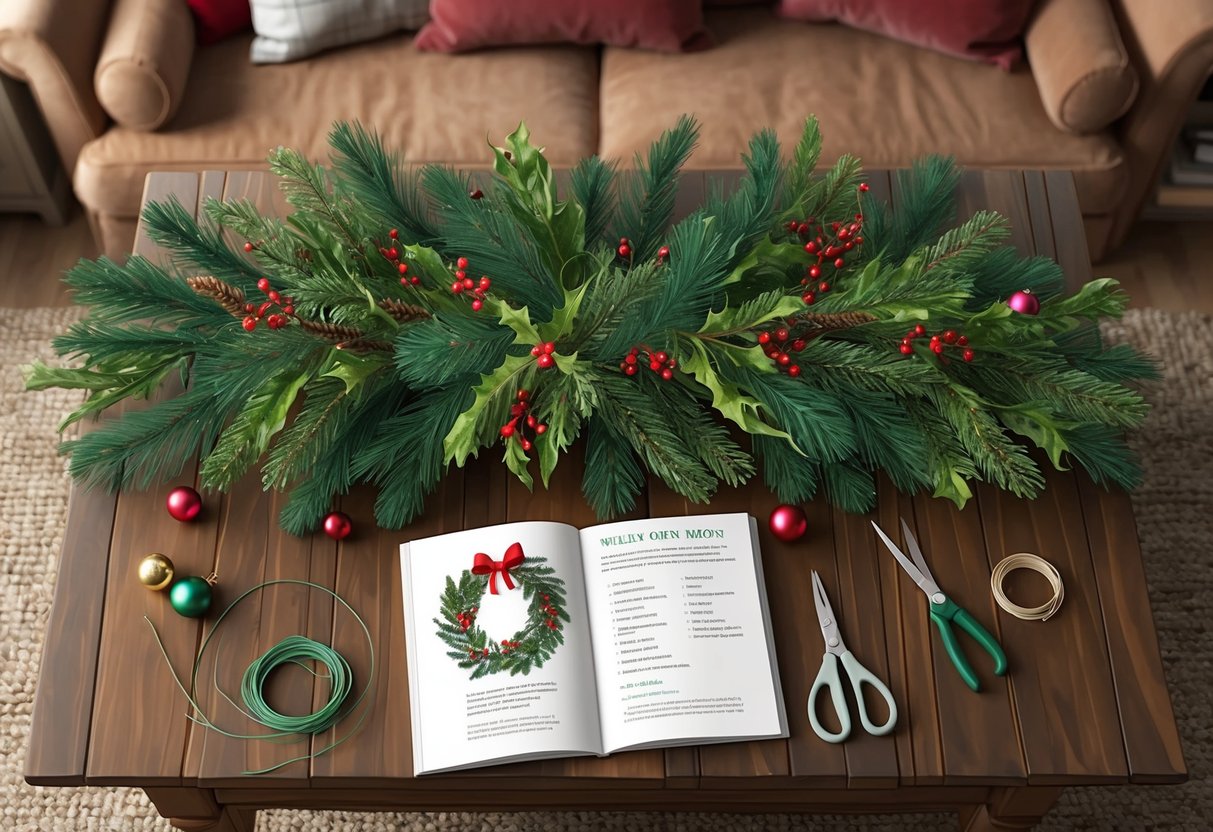
Attaching Greenery to the Base
Begin by anchoring larger pieces of greenery onto the wreath base. Wire wreath forms, grapevine bases, and foam rings are all popular options for structure.
Use short stems and trim any excess foliage with pruners for a cleaner look. Stack greens in sections, overlapping each layer so that the cut ends are hidden by the next bunch.
Pay attention to symmetry and fullness, adjusting pieces as necessary. Mixing textures, such as glossy holly leaves and soft fir branches, creates depth and visual interest.
Consistently check for gaps or spaces as you attach more greenery. Step back occasionally to view the wreath as a whole.
Adjust bunches as needed to achieve even coverage and an appealing shape throughout the arrangement.
Securing Elements with Floral Wire
Wrap floral wire tightly around the stems and base, making sure the wire is snug but not so tight that it damages the materials. Start at one point and work your way around, adding more wire as needed for heavier bunches or decorative elements.
Cut small lengths of wire—usually 6 to 8 inches—for attaching individual pieces like berries or ornaments. Twist the wire ends at the back of the wreath, tucking them in to keep the appearance neat.
This step is crucial for a polished, long-lasting wreath, as highlighted in detailed wreath making tutorials. Test the security of the wreath by gently shaking it before hanging.
If anything feels loose, reinforce that section with another wrap of wire to guarantee stability. This method works well for both natural and artificial elements.
Creative Holiday Wreath Design Ideas
Holiday wreaths for the front door can be tailored to match classic or contemporary home styles, using versatile materials from pinecones and berries to wire hoops and eucalyptus. Design choices can set the mood for any holiday season and allow for endless personalization with color, texture, and structure.
Traditional Christmas Wreaths
Traditional Christmas wreaths often feature lush greenery such as evergreen, pine, or fir branches for a full and festive appearance. These wreaths are usually accented with classic decorations like red berries, pinecones, cinnamon sticks, or velvet bows.
Ornaments in shades of gold, green, or red can be attached for extra sparkle. Many crafters use a circular wire frame or grapevine base to ensure a sturdy structure that keeps its shape throughout the season.
For a DIY wreath, natural elements sourced from the garden or market work well and add a timeless touch. A floral wire is essential to secure the branches, and hot glue helps attach smaller accents.
For a detailed walk-through and photo examples, Gardeners’ World showcases Christmas wreath ideas that can help guide both beginners and experienced makers.
Modern Minimalist Wreath Styles
Modern minimalist wreaths highlight clean lines and a “less is more” approach, often using simple materials and open space within the design. These wreaths may feature a bare wire hoop or metal ring adorned with a single variety of foliage, such as eucalyptus, magnolia leaves, or bay.
Accents are subdued—think: a sprig of dried lavender, a geometric ornament, or a loop of monochrome ribbon. The arrangement focuses on bold shapes and negative space, offering a fresh and stylish alternative to traditional wreaths.
Minimalist diy wreath projects are popular for those seeking quick assembly with minimal supplies. For example, Food52 shares an easy wreath guide adaptable to any season or décor style, which is ideal for those who prefer subtle holiday décor.
Incorporating Natural Elements
Natural elements like fragrant evergreens, eucalyptus, acorns, and pinecones bring authentic texture, subtle colors, and pleasing aromas to handmade holiday wreaths. Choosing the right materials and arranging them carefully results in a wreath that looks inviting and lasts throughout the festive season.
Using Eucalyptus and Evergreen Branches
Eucalyptus and evergreen branches are essential for a wreath base that appears full and lush. Eucalyptus adds a silvery-green tone and a refreshing scent while being flexible enough to weave easily.
Evergreen boughs, such as pine, cedar, or fir, contribute deep green hues and a classic holiday aroma. When combining these materials, stagger the branches to ensure an even, natural-looking arrangement.
For a neat finish, secure the stems firmly to the wire wreath frame with floral wire or green twine. Mixing different leaf shapes and needle textures helps the wreath look more dynamic and visually appealing.
A useful tip is to mist the foliage with water every few days. This helps prevent drying and extends the life of the wreath on an outdoor door.
For more detailed steps and inspiration, this DIY wreath guide provides valuable insights into choosing and arranging fresh foliage.
Adding Acorns and Pinecones
Acorns and pinecones add subtle decoration and earthy accents to any holiday wreath. These elements bring variety in color and shape, making the wreath look more detailed and unique.
Attach pinecones and acorns after placing the greenery. Use hot glue or florists’ wire to secure them, focusing on areas where the wreath needs visual interest or extra dimension.
Grouping acorns in small clusters or mixing different sizes of pinecones can create a balanced appearance. For a natural look, do not overuse these decorative accents.
Acorns and pinecones complement the foliage and make the wreath feel handcrafted and warm. Collecting materials from the yard or local park is economical and eco-friendly, as explained in this step-by-step wreath craft guide.



